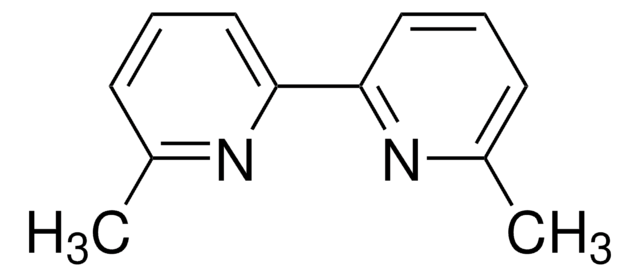It can be used for Cu(I) detection, range 0.1-10 ppm, as it is a Cu(I)-specific colorimetric reagent. It is also an organic electron transporting material.
Kluczowe dokumenty
140910
Bathocuproine
96%
Synonim(y):
2,9-Dimethyl-4,7-diphenyl-1,10-phenanthroline, BCP
Wybierz wielkość
342,00 zł
Wybierz wielkość
About This Item
342,00 zł
Polecane produkty
Próba
96%
Formularz
powder
charakterystyka ekologicznej alternatywy
Design for Energy Efficiency
Learn more about the Principles of Green Chemistry.
sustainability
Greener Alternative Product
mp
279-283 °C (lit.)
λmaks.
~280 nm in methanol
Energia orbitalna
HOMO 7 eV
LUMO 3.5 eV
Wydajność urządzenia OLED
ITO/CuPc/NPD/TCTA/mCP:FIrpic (6%)/BCP/LiF/Al
- Color: blue
- Max. EQE: 4.2 %
ITO/NPD/CBP:Ir(ppy)3/BCP/Alq3/Mg:Al
- Color: green
- Max. Luminance: 100000 Cd/m2
- Max. EQE: 8 %
- Turn-On Voltage: 4.3 V
ITO/NPD/TCTA/BCPO:Ir(piq)3 (7-8%)/BCP/Alq3/LiF/Al
- Color: red
- Max. Luminance: 24529 Cd/m2
- Max. EQE: 17 %
- Turn-On Voltage: 2.7 V
ITO/NPD/TCTA/BCPO:Ir(ppy)3 (7-8%)/BCP/Alq3/LiF/Al
- Color: green
- Max. Luminance: 207839 Cd/m2
- Max. EQE: 21.6 %
- Turn-On Voltage: 2.1 V
kategoria ekologicznej alternatywy
, Enabling
ciąg SMILES
Cc1cc(-c2ccccc2)c3ccc4c(cc(C)nc4c3n1)-c5ccccc5
InChI
1S/C26H20N2/c1-17-15-23(19-9-5-3-6-10-19)21-13-14-22-24(20-11-7-4-8-12-20)16-18(2)28-26(22)25(21)27-17/h3-16H,1-2H3
Klucz InChI
STTGYIUESPWXOW-UHFFFAOYSA-N
Szukasz podobnych produktów? Odwiedź Przewodnik dotyczący porównywania produktów
Opis ogólny
Zastosowanie
Hasło ostrzegawcze
Warning
Zwroty wskazujące rodzaj zagrożenia
Zwroty wskazujące środki ostrożności
Klasyfikacja zagrożeń
Acute Tox. 4 Oral - Aquatic Chronic 4
Kod klasy składowania
11 - Combustible Solids
Klasa zagrożenia wodnego (WGK)
WGK 3
Temperatura zapłonu (°F)
Not applicable
Temperatura zapłonu (°C)
Not applicable
Środki ochrony indywidualnej
dust mask type N95 (US), Eyeshields, Faceshields, Gloves
Wybierz jedną z najnowszych wersji:
Masz już ten produkt?
Dokumenty związane z niedawno zakupionymi produktami zostały zamieszczone w Bibliotece dokumentów.
Klienci oglądali również te produkty
Produkty
Explore the eco-friendly potential of organic thin film transistors (OTFTs) for detecting chemical analytes, identifying viruses, and assisting in health diagnostics. This mini-review highlights challenges of achieving sustainability, safety, and biodegradability of each component of an OTFT sensor.
Professor Shinar highlights low-cost, disposable sensor configurations in organic and hybrid electronics for healthcare applications.
Professor Chen (Nankai University, China) and his team explain the strategies behind their recent record-breaking organic solar cells, reaching a power conversion efficiency of 17.3%.
-
What are the possible applications for Product 140910, Bathocuproine?
1 answer-
Helpful?
-
-
What is the maximum absorbance wavelength for Product 140910, Bathocuproine?
1 answer-
The ?max is at approximately 280 nm in methanol.
Helpful?
-
-
What solvents can be used to dissolve Product 140910, Bathocuproine?
1 answer-
This product can be dissolved in 5% pyridine to yield a dark yellow solution. It is also soluble in methanol (36 mg/100ml), isoamyl alcohol (18 mg/100 ml), dioxane (100 mg/ml), 95% ethanol (50 mg/ml) and nitrobenzene.
Helpful?
-
-
What is the Department of Transportation shipping information for this product?
1 answer-
Transportation information can be found in Section 14 of the product's (M)SDS.To access the shipping information for this material, use the link on the product detail page for the product.
Helpful?
-
Active Filters
Nasz zespół naukowców ma doświadczenie we wszystkich obszarach badań, w tym w naukach przyrodniczych, materiałoznawstwie, syntezie chemicznej, chromatografii, analityce i wielu innych dziedzinach.
Skontaktuj się z zespołem ds. pomocy technicznej



![[6,6]-Phenyl C61 butyric acid methyl ester ≥99%](/deepweb/assets/sigmaaldrich/product/structures/359/221/d990c746-0960-4c69-bf76-fe09b193824d/640/d990c746-0960-4c69-bf76-fe09b193824d.png)






